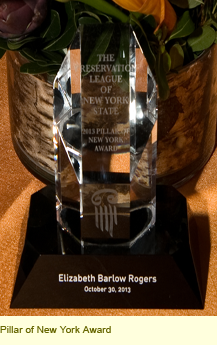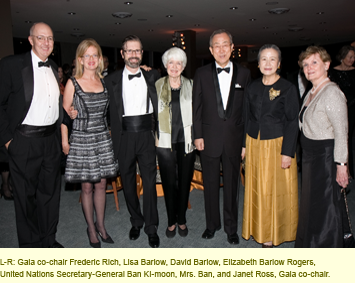People
- Congratulations to Therese O'Malley, retiring from the Center, National Gallery (1982-2021)
- 2020 Place Maker / Place Keeper Honorees
- Congratulations to Elizabeth K. Meyer!
- Congratulations to Reuben Rainey!
- Meet Betsy Smith, newly appointed president of the Central Park Conservancy as she steps into the shoes of Douglas Blonsky
- As retiring president and CEO of the Central Park Conservancy, Douglas Blonsky leaves behind an extraordinary legacy
- Board Member Robin Karson made honorary member of the American Society of Landscape Architects
- Board Member Laurie Olin is honored by the National Building Museum
- Gold Medal Winner
- Women Who Made New York
- Germany's Green Prince
- 2016 Place Maker / Place Keeper Honorees
- 2015 Place Maker / Place Keeper / Lifetime Achievement Honorees
- Kudos for Board Member Laurie Olin
- Celebrate our 2014 Place Maker and Place Keeper Awardees
- Pillar of New York Award
- Spotlight on Board Members
Pillar of New York Award
 On October 30 at a gala celebrating the $1.8 billion restoration of the 1952 United Nations complex and the $500 million rebuilding of Central Park by the Central Park Conservancy in partnership with the New York City Department of Parks I was honored to receive the Preservation League of New York State’s 2013 Pillar of New York award in the company of co-awardee Ban Ki-moon, United Nations Secretary-General.
On October 30 at a gala celebrating the $1.8 billion restoration of the 1952 United Nations complex and the $500 million rebuilding of Central Park by the Central Park Conservancy in partnership with the New York City Department of Parks I was honored to receive the Preservation League of New York State’s 2013 Pillar of New York award in the company of co-awardee Ban Ki-moon, United Nations Secretary-General.
At the event, which offered guests a special preview tour of the Trusteeship Council Chamber, Security Council Chamber, and Economic and Social Council Chamber of the reborn UN, Ann Van Ingen, chairman of the Preservation League of New York, spoke of the UN and Central Park as “two oases in our city, our state, our country and, indeed, our world.”
Explaining the Preservation League’s decision to present Secretary-General Ban Ki-moon with its Pillar of New York Award in recognition of the UN’s successful implementation of its Capital Master Plan, Van Ingen said, “Sixty-eight years ago—on October 24, 1945—a vision for peace, development, and human rights took root and flourished right here. But the complex, constructed in the early 1950s, had aged considerably and lacked the standards that are expected in modern and safe buildings. Its current reincarnation is a triumph for historic preservation.”
 After presenting the Secretary-General with the Pillar of New York award in recognition of his role in bringing the UN’s physical renewal to fruition, she praised the rebirth of Central Park over the thirty-three years since I helped found the Central Park Conservancy. She also recognized my role in creating the Foundation for Landscape Studies and editing its journal Site/Lines while also authoring four books on the subject of place.
After presenting the Secretary-General with the Pillar of New York award in recognition of his role in bringing the UN’s physical renewal to fruition, she praised the rebirth of Central Park over the thirty-three years since I helped found the Central Park Conservancy. She also recognized my role in creating the Foundation for Landscape Studies and editing its journal Site/Lines while also authoring four books on the subject of place.
In the speech following my acceptance of the award I took the opportunity to remark on the sea change that had occurred during my lifetime with regard to the meaning of new and old in the built environment and how the preservation ethos had come to designate as historic the kind of design that once sought to achieve a radical break with history. Both the Delegates’ Lounge room where event took place and the view of Roosevelt Island and its Four Freedoms Park with the new FDR memorial by Louis Kahn inspired the following comments regarding Le Corbusier’s then radical 1951 design of the United Nations and Frederick Law Olmsted and Calvert Vaux’s revolutionary design of Central Park in 1858.
When Modern Became Modernism: The Coming of Age of Historic Preservation
When I moved to New York in 1964, this miracle of modernism where we now sit was only twelve years old. Notice that I just said modernism. That wasn’t the way we spoke of buildings like the United Nations back then. This was modern, not modernist architecture, an important distinction.
Remember how Le Corbusier famously railed against what he called “the styles,” all those “isms”—Gothicism, neoclassicism, Romanticism, and the overall eclectic historicism of nineteenth-century architecture. Modern was considered the antithesis of the styles. It was not a style. It was the FUTURE. It was machine technology in the service of social equality.
And what could express the hope of the future more powerfully than the building where we are tonight? This modern architectural masterpiece designed by an eleven-man team led by Le Corbusier, Oscar Niemeyer, and Wallace K. Harrison was both a promise to strive for world peace and a paradigm for the use of steel framing and glass-curtain walls as our mainstream construction technology.
Unfortunately, in the hands of lesser architects much modern architecture did not rise to the same level of beauty as the United Nations Secretariat. Moreover, Le Corbusier’s influence as a cultural arbiter engendered an indifference to the urban fabric of the past that resulted in the destruction of some of our great Beaux-Arts monuments, including Penn Station in 1963.
This era also saw the beginning of a long period of amnesia with regard to Frederick Law Olmsted and Calvert Vaux’s magnificent creation, Central Park, resulting in two decades of decline and degradation.
Fortunately, there were those who did not see the destruction and neglect of the past as acceptable. This gave rise to the birth of the historic-preservation movement and the founding of the New York City Landmarks Commission, a public agency, and the Preservation League of New York State, a civic organization championing the coexistence of the old with the new.
Somewhat ironically, in time, as newer kinds of architecture appeared on the scene, modern architecture began to be considered a style—another “ism.” Now the rescue of great landmarks of architectural modernism is one of the important imperatives of historic preservation. Landscape landmarks are also receiving their due, thanks to public-private parks organizations such as the Central Park Conservancy.
That we are simultaneously celebrating the historic preservation of the United Nations and Central Park is for me personally thrilling. Tonight I am both humbled and honored to represent one-half of the equation between the restoration of a great, nineteenth-century, American landscape and the renewal of a globally significant, mid-twentieth-century work of architecture in the company of our host tonight, Secretary General Ban Ki-moon, whose leadership of this great congress of nations and the renewal of the building that houses it represent the other half of the equation.
